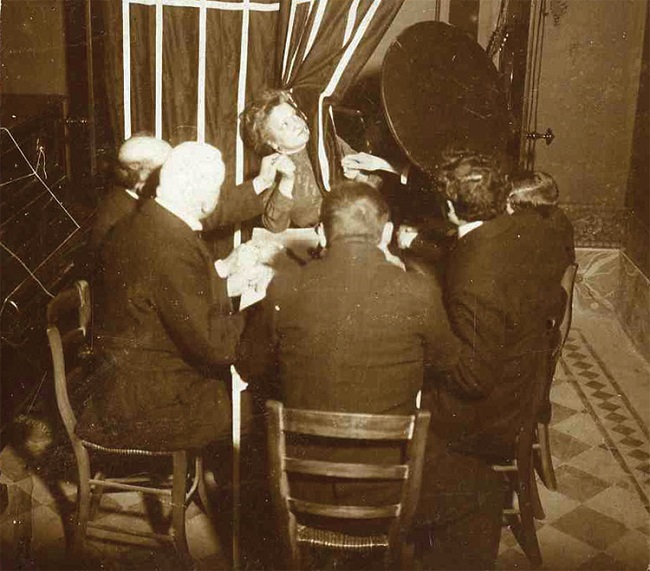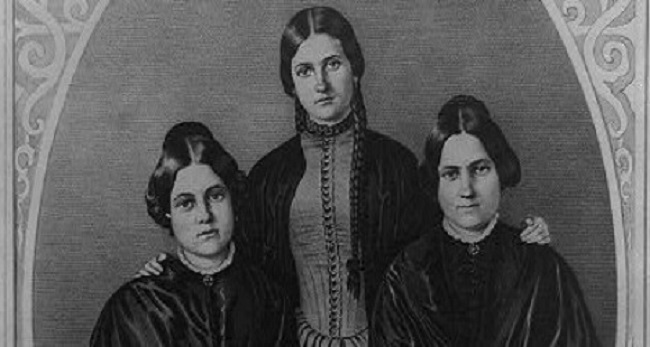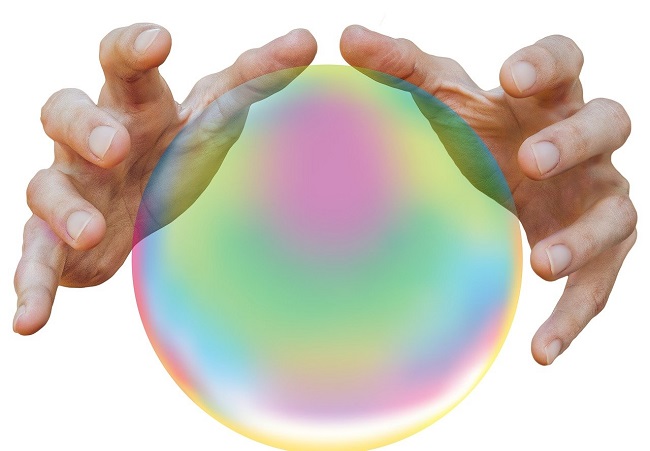Most of us would do—and many have done–just about anything to be able to communicate with our deceased loved ones just one more time. We are never really prepared for the death of those closest to us. Instead, we are left wanting just a bit more closure, a bit less of an unsettling conclusion, or a confirmation of forgiveness for any unkind thing we might have said or done in an off moment of being human.
Enter the 95,000+ multi-billion-dollar business of the psychic medium. These are specialized professionals who claim they have the ability to hear from your beloved, and for just a few hundred to a few thousand dollars per private reading session, they can deliver a message to you from the “other side”.
One of the most influential mediums of the late nineteenth and early twentieth centuries was a middle-aged woman who some referred to as the diva of the supernational, Eusapia Palladino (1854-1918). Palladino, who was born in a province of Bari of humble beginnings, went from being an uneducated and illiterate orphan child, to eventually being sought after by the wealthy and most prestigious members of the international scene, including Broadway stars, Nobel Prize laureates Marie and Pierre Curie, and world-renowned Italian psychiatrist and criminologist Cesare Lombroso. Attendees around her séance table swore they saw and heard her contact the dead. Palladino’s managers booked her seances in her native Italy, England, France, Poland, Russia, Germany, and the United States. News accounts spread with tabloid sensationalism by witnesses who say they saw tables levitating, objects moving, curtains waving, body parts materializing and lights flashing when the entranced Eusapia channeled her spirit guide “John King.”

Astrophysicist Neil deGrasse Tyson once said that eyewitness testimony is the least reliable evidence that exists, albeit disturbingly the most important evidence in courts of law. What we see and hear, we then interpret based on our own perception and experiences. Often, we see what we want to see. This does not meet the criteria for scientific objectivity.
Human beings have been drawn to spiritualism and the possibility of being able to receive messages from the dead long before Eusapia Palladino rose to fame. The Bible is filled with stories of angels talking to earthly beings. Italian Catholics like my own family “talked” to saints as if chatting over a cup of coffee. But the contemporary spiritualist craze exploded in the mid-1800s in a little one-bedroom cottage in Hydesville, NY, where sisters Maggie, 14 years old, and Katie, 11 years of age, drew attention with their stories of hearing strange sounds in their room, at all hours of the night and day. Neighbors who went to witness this phenomenon for themselves came away mesmerized by how these “taps” would alphabetically spell out certain words. Once the word spread, people from everywhere would come to the sisters’ sittings, which was eventually turned into a very lucrative business. But the taps, it was discovered, were actually generated from a special ability the sisters had to crack the knuckles of their toes so imperceptibly as to not show any movement of the feet. The old wooden floorboards then amplified the sound, making it appear to bounce off all four walls of the room.
Eusapia Palladino, was also caught using trickery throughout her career, and even admitted to it. Yet blind credulity, even among some respected behavioral scientists would continue to persist. Ultimately, the American branch of the Society for Psychic Research demonstrated conclusively that her powers were due to trickery, such as making her sitters believe she was touching them with both hands when she was really only touching them with one. (she would slowly move together the hands of the sitters on either side of her, and slide her own hand out of the “chain.”. The objects that moved across the table during her seances, happen to have been pulled with a hair, which of course could not be seen in the dark. Palladino’s own hand or foot would be what caused a curtain to be moved. And so on.
In the US, paranormal beliefs have given birth to a number of popular TV shows that often get broadcasted in Italy, such as Ghost Hunters and The X-Files, and the American Horror film, “Paranormal Activity” (2010). Popular media psychics, when “reading” audience members, tend to use either “cold” or “hot” reading techniques. Cold readings are when general statements or questions are posed to the crowd, almost ensuring that the statement will apply to someone in the audience. For instance, “I am seeing the number 2, does anyone here identify with the number two, or the second month of the year?” As soon as someone confirms, then additional open-ended questions are asked. If the “sitter” disconfirms, the medium quickly goes on to another topic or advises the person to remember that information as they will know what it means later.
Hot readings, on the other hand, are becoming more popular now with the rise of technology. They occur when information about audience members has been researched on a person’s social media before the reading. For example, if one purchases a private reading session or an audience ticket through something like Ticket Master—basic information can be gleaned from one’s credit card, then on to Facebook or the attendee’s other social media where more personal information can be gathered before the reading.
Ultimately, our beliefs are personal, and no one has the right to judge another for believing or not in the world of psychics or in the veracity of a séance. Psychic “readings” may provide comfort to some, but for others, they might disappoint and compound grief. Whatever you choose, it is important at least to be informed and aware before you spend your hard-earned money on a very generalized message such as “Your loved one is okay”.
So why do we believe in psychic phenomena without scientific proof based on research studies that have investigated and confirmed its validity?
One reason we are most vulnerable when experiencing grief. We have a desperate need to make sense out of losing someone who was such an important part of our lives. Another reason we are eager to believe is what is known as the “fallacy of positive instances”; that is a tendency to better remember positive or correct guesses. For example,” Your father is showing me a dog,” (when the person’s father really did have a dog). We then minimize or ignore the many more incorrect statements in that same reading. Another reason we believe without question has to do with the Barnum Effect, where people tend to agree with the accuracy of general statements, which actually can be true for anyone.
If you do plan to seek a communication from your loved one from a psychic medium, consider the following points so you can go with your eyes wide open.
- if your loved one had a message for you, would they really give it to a stranger, instead of to you directly?
- There have been no controlled research studies definitively confirming the ability of mediums to communicate with the dead.
- Weigh the value of whatever message you are likely to receive with the amount of money the psychic is charging for their service. If they claim they do this work because they want to help and comfort people, it is unlikely their clients will find comfort in emptying out their bank accounts.
Eusapia Palladino was quite convincing. Even today, over 100 years later, her history of deception is still sometimes brushed aside by those who write and teach about her. The reality is, there is no shortcut to the journey through grief. Time, as they say, really is the ultimate healer. In the meantime, a more reliable alternative to a psychic reading might be seeking the support and comfort of friends, family, and professional grief counselors who may not have the psychic radar to hear that your loved one is okay, but who can certainly help to make sure that you will be.
References/ For Further Reading:
Graus, Andea (2016). Discovering Palladino’s mediumship, Otero Acevedo, Lombroso and the quest for authority. Journal of the History of the Behavioral Sciences, Vol 52(3), 211-230.
Bader, C.Dl, Molle, Al, & Baker, J.O. (2012). Countervailing forces: Religiosity and paranormal belief in Italy. Journal for the Scientific Study of Religion. 51(4): 705-720.
Emily Williams Kelly, Ph.D. & Dianne Arcangel, MA (2011). An investigation of mediums who claim to give information about deceased persons. The Journal of Nervous and Mental Disease, Vol 199 (1).
Massimo Polidoro (2016). Theresa Caputo: The fake Long Island medium. The Skeptical Inquirer. Vol 40(3).
Massimo Polidoro (2005). The story of a ‘greata’ medium. The Skeptical Inquirer. Vol 29(4).
Molle, A., & Bader, C. (2014). ‘Paranormal Science’ from America to Italy: A case of cultural homogenization. In O. Jenzen and S.R. Munt. Farnham (Eds.), The Ashgate research comparison to paranormal cultures (pp121-138). Farnham, UK:Ashgate.
Sarraf, M., Woodley, M.A., & Tressoldi, P. (2020) Anomalous information reception by mediums: A meta-analysis of the scientific evidence. Explore 17, 396-402.
Enoksen, A.E, & Dickerson, P. (2018). ‘That proves my point’: How mediums reconstrue disconfirmation in medium-sitter interactions. The British Psychological Society, 57, 386-403.
Carlos S. Alvarado & Massimo Biondi (2017). Cesare Lombroso on mediumship and pathology. History of Psychiatry. Vol 28(2), 225-241
Francesco Paolo de Ceglia & Lorenzo Lepoiere (2020). Becoming Eusapia: The rise of the “Diva of Scientists”. Science in Context, 33, 441-471.






